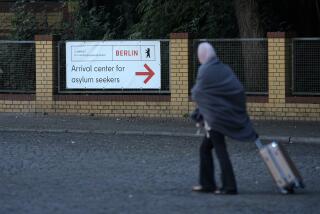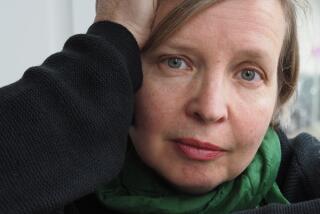Cruising in East Berlin
- Share via
WEST BERLIN — My wife and I have just returned from rowing quietly in a small boat along the River Spree in East Berlin, on the other side of the ominous wall that divides a city celebrating its 750th birthday.
Berlin was born on and around the island of Coelln in the River Spree, which flows through both East and West Berlin, at times forming part of the border that has been walled and patrolled by the communist government of East Germany for more than a quarter of a century. The historic island is in East Berlin.
A short walk from where the Spree is part of the border, near East Berlin’s Treptower Park S-Bahn station for elevated commuter trains, we had found a marina with rowboat rentals.
We asked for a rental at the dockside office and offered our passports for identification. The dock manager told us with a grin that we were the first Americans to come to his window to rent a rowboat.
When we arrived here in late June, West Berlin tourism authorities welcomed us to explore their waterways by tour boats as well as our own canoe, expressing the wish that more visitors could be encouraged to go beyond the popular sightseeing bus routes to get closer to the heartbeat of the city.
East Berlin tourism officials were equally enthusiastic about our traveling aboard the cruise boats, but they said that we would not be able to take our canoe through the passport and visa checkpoints because the Spree is part of the boundary. Tickets for the three-hour round-trip cruise were about $3 each.
From the Spree we cruised to the resorts around East Berlin’s biggest lake, the Muegellsee, lunching and sipping beer with mostly East German families and visitors out for an afternoon on the water.
After the cruise boat returned to Trep Tower Park we walked along the river to see if we could find a place to rent a canoe, kayak or rowboat. The marina that we came upon is part of the park’s recreation area covering many acres. It has walking paths and a children’s amusement center with a giant Ferris wheel.
Haus Zenner is a terraced restaurant beside the river. Outdoor tables were shaded by umbrellas marked with the emblem of Berlin’s 750th anniversary. A lively band played on the lower terrace.
After glancing at our passports and East Berlin visas, the manager asked for the usual deposit of 20 marks, about $11, and quoted the hourly rental of about $1.25. Then he picked up two sets of oars and walked with us to the end of the pier where an East German couple with two small children also were ready to board a rental rowboat.
He helped the children into their boat and briefly told all of us about the safety regulations. We should stay close enough to the river bank to give maximum clearance to the barge and passenger boat traffic. We could row toward the river Muegellsee as far as we wanted to go but should not row in the other direction beyond a marker in the water that is the boundary between East and West Berlin.
He waved us off, and we were on our own. The children cheered their father when he paddled vigorously enough to pass us at our leisurely pace.
We were content to drift along like Huck Finns far from the Mississippi. The scenery varied from industrial plants with docking and loading facilities to parks, gardens, marinas and residential apartments.
Two old villas were being used as club houses for rowing organizations. Racing slips were stacked beside the entrances.
After a couple of hours of rowing on the Spree we returned to the marina and afternoon coffee and cake at a river-side table in front of the Haus Zenner, which received its original license as a pub in 1792. Two couples danced to the band’s toe-tapping tunes.
The sightseeing cruise boat docks near here. It is part of the Weisse Flotte, a fleet of 40 boats for river and lake cruising.
Where the City Began
A brief S-Bahn elevated train ride took us back into the center of East Berlin, and we walked to the island of Coelln, where the city started in 1237 AD with the merging of a small community on the island and another called Berlin on the right bank of the Spree.
Unless you stroll with shoppers and window shoppers along an avenue such as Unter den Linden, crossing bridges over the river on both sides of the island, it’s difficult to realize that Coelln is an island.
The 18th-Century cathedral, the museums, theaters, fine hotels and other historic, contemporary and restored buildings blend into the old and new center of the city, beneath the TD Tower and the new high-rise Hotel Stadt Berlin.
Appreciating a Contrast
The quiet of cruising and paddling the Spree, then walking the river banks and bridges, provided a contrast that gave us greater appreciation for the scope of the restoration for their 750th anniversary year in East Berlin’s historic center around St. Nicholas Church.
The church dates back to 1380 when the river was the main channel of traffic. Tourism officials in West Berlin had urged us not to miss the restoration and new building in East Berlin.
We dined beside the picture window of the new Am Marstall restaurant near the Spree and in the restoration area. Dinner for two, poached salmon, with an East German white wine, dessert and coffee, was about $45.
We were 2 marks short of covering this tab in East German currency. Rather than overload us with East German marks by changing a 100-mark West German bank note, the young waitress smiled and told us to forget the 2 marks. She also steamed off the label from the wine bottle for the collection of labels my wife has been putting together from around the world.
The East Berlin couple at the next table offered to pay the 2 marks difference (about $1.10 U.S.); we had overheard and talked about their dining early to attend a Summer Film Festival event that is part of a year-long schedule of Berlin’s 750th birthday celebration.
It’s hard to get away from all the excitement and attractions that surround a visitor along and around the Kurfuerstendamm, the Champs-Elysees of West Berlin.
Along with West Berlin’s grand hotels, theaters, museums and festivals, Charlottenburg Palace and other historic sites, 5,000-plus restaurants and cafes, and all of the 750th birthday events, the city of nearly 2 million people is also a resort center.
Fully a third of Berlin is covered by forests and parks, hills with 700 kilometers of walking paths, plus lakes and rivers that span a greater area than Bavaria’s three most famous lakes. In a garden near city center we found Literatur Haus, a restaurant that combines dining with a classic collection of books and photos.
For an overview we took the S-Bahn elevated train through Gruenewald Park and Forest to the lake called Wannsee, created by the River Havel that flows into the Elbe River and on past Hamburg to the North Sea.
At the Wannsee we boarded a sightseeing boat for a cruise of nearly four hours along the Havel and up to the many resorts around Tegelersee. Near this lake the River Spree flows into the Havel.
The white-sand beach at Wannsee is a mile long and 250 feet wide, Europe’s largest inland beach. Peacock Island is one of the most popular excursions for West Berliners; it is both a bird sanctuary and site of a romantic castle.
Forests, walking paths, bicycle trails and resort hotels lie on the banks of the Havel and its lakes. Seventy sightseeing boats offer cruises of varying lengths. Our long cruise was about $10 per person. Lunch, snacks, desserts, soft drinks, wines and beers are served aboard.
We shared the waterways with windsurfers, sailboats, small power boats. Rowing skiffs from schools and clubs tried to pass us or keep pace. Kayaks, canoes and rowboats stayed closer to the banks. Barges with the DDR insignia of East Germany moved out of the Spree and along the Havel toward the Elbe.
We returned to the Havel and its lakes in our canoe and also paddled along the Spree toward where waters flow out of East Berlin.
A West German businessman told us as we passed a DDR barge on the Havel River: “We are two different countries now, each prosperous in its own way. We already do business with each other, but the East as well as the West should be able to visit just with passports and visas, without any Wall.”
More to Read
Sign up for The Wild
We’ll help you find the best places to hike, bike and run, as well as the perfect silent spots for meditation and yoga.
You may occasionally receive promotional content from the Los Angeles Times.






